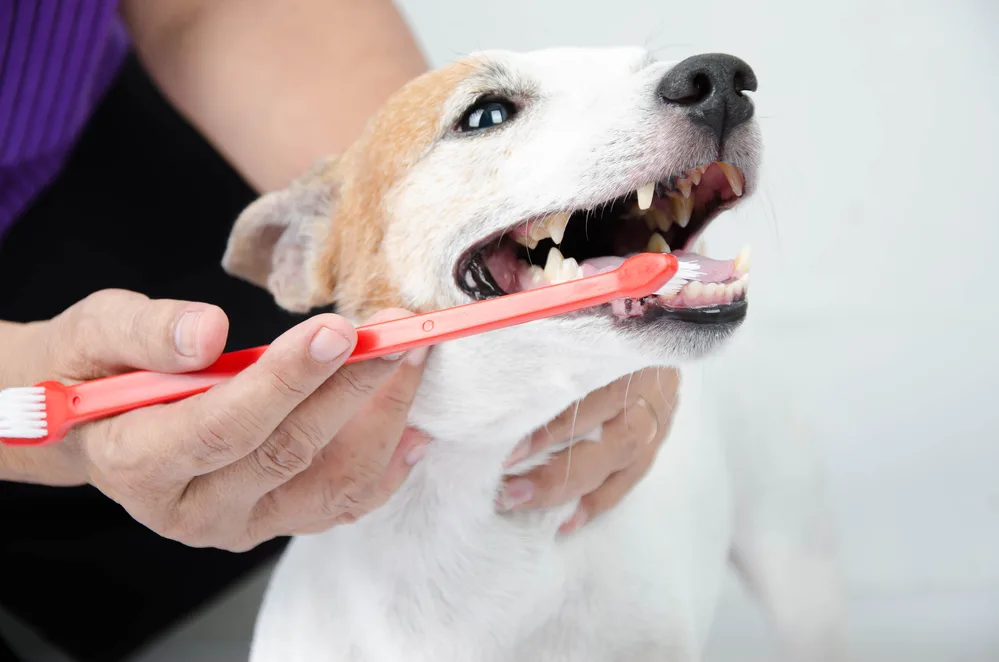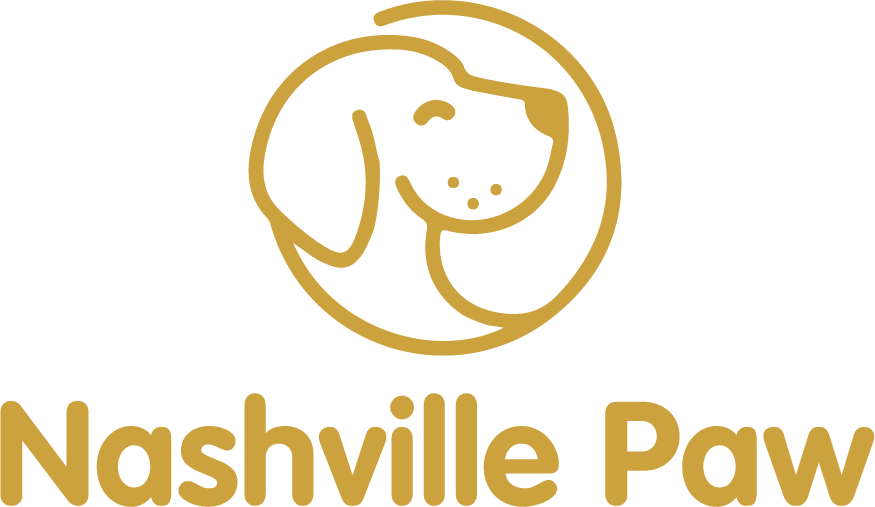Dog breath doesn’t smell like roses.
However, getting a whiff shouldn’t be so bad that it makes you gag!
Why does my dog’s breath smell so bad?
There are many reasons for smelly breath. Sometimes, health problems can leave your dog’s mouth worse for wear. Other times, bad breath is due to poor lifestyle habits. Fixing your dog’s breath can be simple.
Before you can fix mouth odors, you need to know what’s causing the terrible stench. Once you’ve narrowed down the causes, you can start solving the problem.
If your dog’s breath has you running for the hills, don’t worry! Keep reading to learn how to make your dog smell minty fresh!
6 Reasons Why Your Dog’s Breath Stinks

There are several causes of halitosis in dogs that veterinary professionals have identified. Most are common occurrences that have simple fixes.
However, your dog’s breath could stink due to underlying medical conditions. Finding the source of the problem is a game of trial and elimination.
Check and see if your pup has any of these issues. If so, you’re halfway to curing your dog’s halitosis!
Reason One: Poor Oral Hygiene
Did you know your dog needs a dental hygiene routine, just like you? Most owners don’t know they must brush their dog’s teeth regularly.
Poor oral care is the most common cause of canine bad breath. Plaque and tartar build-up and feed bacteria that release foul odors.
Your dog might also be hiding something under his gums. Sticks, fabric from toys, and old food can wedge between their teeth.
Rotting debris may also be the culprit behind the nasty smell. The worst case scenario is an oral tumor, so check his mouth frequently.
Reason Two: Kidney Disease
Many dog owners think that bad breath is unique to oral problems. However, smelly odors could be a sign of kidney disease in dogs.
Kidneys work by removing waste from your dog’s system. You’ll know they aren’t functioning correctly if his breath smells like a bathroom.
When the kidneys stop working, they can’t filter toxins from your dog’s body. This build-up could also contribute to the strange-smelling odors.
Reason Three: Liver Disease
If the kidneys and mouth are fine, turn to the liver for answers. The liver also acts as a waste filter; if it’s not working, the gathering of toxins will produce a mouth odor.
Your dog’s liver is a likely offender if the bad breath comes with vomiting, yellow eyes and gums (jaundice), and weight loss.
Liver and kidney diseases are very serious illnesses. If you think your dog might be suffering from these conditions, call your vet ASAP.
Reason Four: Diabetes
Unfortunately, halitosis could point to many different illnesses. It’s not always a simple fix; you may need a vet visit to uncover the source.
For example, did you know that your dog’s bad breath could be a symptom of canine diabetes? Diabetic dogs break down fat and release something called ketones into their systems.
The result? A sweet but unpleasant smell comes from your dog’s mouth. While this might not be as bad as other odors, it’s still a cause for concern.
Diabetes is tricky since it can lead to other organ failures. You could be dealing with a diabetic dog with kidney and liver problems!
Keep track of your pup’s daily habits. If he’s losing weight while gobbling up food and drinking like a camel, your vet should do a diabetes screening.
Reason Five: Intestinal Issues
Dogs can suffer from so many stomach problems. These issues could also be why your dog’s breath smells so bad.
Intestinal illnesses like parasites often come with a strange smell. The odor occurs when bad stomach bacteria outweighs good bacteria.
If your dog gags but doesn’t throw up while producing foul mouth odors, intestinal issues could be the cause. Always address stomach problems as soon as possible to avoid weight loss and dehydration.
Reason Six: Unhealthy Diet
Of course, not every cause of canine halitosis is a scary medical diagnosis! Sometimes, it’s as simple as the food your dog eats.
Many popular dog foods contain poor-quality ingredients. You can expect nasty breath if your dog’s dinner isn’t helping his natural biome.
Tons of owners are also guilty of feeding their pets human-grade food. There’s a reason why dogs can’t eat ice cream and other yummy snacks; it’s because it’s terrible for their health!
Some dogs also experience rancid breath from a raw diet. Many owners fail to add proper nutrients, throwing their dog’s stomach environment out of whack.
Your dog should eat a well-balanced diet just like you do. Reducing gas and bloating from poor dietary choices is the easiest way to eliminate smelly breath.
Reason Seven: Ingesting Something Nasty
It’s no secret that dogs eat everything. Usually, an unusual snack here and there won’t cause many problems. However, ingesting something nasty could result in stinky breath.
It might be harmless, like some leftover pizza or stuff from the cat’s litter box. Bad breath should be your only issue as long as whatever you consume isn’t dangerous.
A problem arises when they eat something toxic. Poisonous plants, human medication, and nicotine products can give off a rotten scent.
Keep an eye out for anything your dog shouldn’t eat. Removing these things from his environment is key to controlling his bad breath.
How to Fix Your Dog’s Smelly Breath

As you can see, there are countless reasons your dog’s breath smells so bad. Don’t let this information scare you; getting rid of nasty mouth odors is easy when you know the cause.
Fido isn’t a lost cause yet. Before giving up on your canine halitosis healing journey, check out these tips on how to fix your dog’s smelly breath.
Step One: Brush Your Dog’s Teeth
The first step is easy; make sure you’re brushing your dog’s teeth every day. Even if the bad breath comes from a different source, this is still a good habit to practice.
You can’t use ordinary dental products on your dog. Instead, find animal-grade toothpaste and a dog-friendly toothbrush to get the job done.
Dogs don’t need 20-minute brushing routines, either. If your pet only tolerates a minute or two of dental care a day, that’s plenty to see an improvement!
If you need a visual aid, check out this video from the American Kennel Club and learn how to brush your dog’s teeth.
Step Two: Use Dental Products
Some dogs won’t put up with any mouth work. In that case, you can substitute brushing with high-quality dental treats instead.
Dental chews work differently; mechanical treats rub plaque and tartar away with a specialized design. Enzymatic treats use pet-safe enzymes to break down debris at a chemical level.
You could also use water additives to freshen your breath quickly. These products work similarly to enzymatic chews; instead of munching on a treat, your dog drinks water additives from his water bowl.
Step Three: Change Their Diet
If canine halitosis is coming from an unhealthy diet, it might be time for a change. Ensure you’re feeding high-quality dog food from a company that performs its feed studies.
You should never switch your dog’s food cold turkey. Instead, gradually introduce the kibble by mixing it with the old brand. Follow these steps for minimal gastrointestinal problems:
For a dog that eats one cup of kibble per meal:
- Week one: mix ¼ cup of the new food with ¾ cup of the old food.
- Week two: mix ½ cup of the new food with ½ cup of the old food.
- Week three: mix ¾ cup of the new food with ¼ cup of the old food.
- Week four: feed one full cup of new food.
These values will differ depending on how much your dog eats. Stop mixing foods and call your veterinarian if you notice any gas, diarrhea, or vomiting.
Once your dog is on his new diet, see if there’s any change in his breath. If it smells fresh and clean, you’re in the clear!
Step Four: Consult a Veterinarian
We’ve covered some things you can do from home to address canine halitosis. But, what happens if bad breath is from an underlying medical condition?
If you’ve tried every home treatment without any luck, it’s time for professional help. Consult your veterinarian to get to the bottom of this smelly odor.
Your vet will ask questions and run tests to see how your dog’s organs function. They may examine kidney, liver, and glucose levels to rule out various diseases.
From there, your veterinarian will suggest the best course of action. If your dog has diabetes, kidney, or liver disease, you should see an improvement in breath odor as treatment goes on.
Your vet will also perform a thorough oral exam to check your dog’s dental health. They may suggest a dental cleaning to clear any plaque, tartar, or rotting teeth causing the stench.
Maintaining good oral hygiene is essential after a dental cleaning. Do you remember that brushing routine we talked about earlier? Now’s the time to whip out the toothbrush and establish a brushing routine.
FAQ’s
How can I get rid of my dog’s bad breath naturally?
Feed your dog crunchy, pet-safe veggies to help scrub their teeth. They will act as a mechanical scrub to remove stinky build-up. Apples and carrots are good vegetables to start with.
Can I make my dental dog treats?
Natural vegetables are the best holistic dog treats. We don’t recommend making your dental treats from home. If you decide to create your recipe, talk to your vet to ensure that all ingredients are pet-safe.
Do certain dog breeds have worse breath than others?
Experts don’t have dog breed halitosis down to a science. However, many owners report that small breeds tend to have worse breath than others. For example, Chihuahuas and Yorkies have high rates of oral disease because of overcrowding.
Bottom Line
Now you know why your dog’s breath smells so bad and how to fix it! Poor diet, bad oral hygiene, and underlying health problems all contribute to canine halitosis.
Whether you change kibble or establish a regular brushing routine, your dog will thank you in the long run. Of course, always consult with a veterinarian before making any major switches.
Gone are the days of putrid stenches and scaring away visitors! Use this helpful article to transform your dog’s oral health and create a better-smelling home. You and your dog are just a few lifestyle changes away from living fresher, happier lives.
